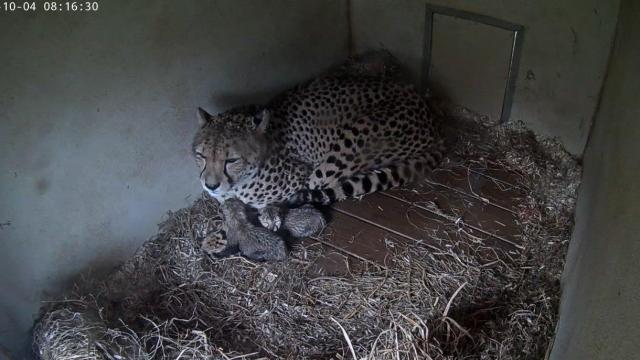Two newborn cheetah cubs at the Smithsonian Conservation Biology Institute in Virginia are the latest stars of the Cheetah Cub Cam, a 24/7 stream of adorable spottedness and big cat cuddles.
Born the night of October 3, the twin cubs are the first offspring of 4-year-old female Amani and her mate, 7-year-old male Asante. According to a National Zoo release, the cubs appear to be strong, vocal, and nursing well.
The zoo’s livestream offers an uninterrupted view into the cheetah’s den at the institute, where the 2-week-old twins mostly hang out and mew. In four weeks, the cubs will receive their first vaccines, according to CNN.
Cheetahs are an endangered species of big cat endemic to Africa. They’re spotted, lanky, and are the fastest land animals on Earth, capable of reaching speeds of about 97 km per hour in short sprints. Though the cats are built for speed, they don’t often reach their top speeds in captivity. Like most endangered species, cheetahs are primarily at risk of extinction due to habitat loss.
“Being able to watch our cheetah family grow, play and explore their surroundings is incredibly special,” said Adrienne Crosier, cheetah biologist at the Smithsonian Zoo and Conservation Biology Institute, in the zoo release. “We hope this experience brings Cheetah Cub Cam viewers joy and helps them feel a deeper connection to this vulnerable species.”

Cheetahs are high-strung animals in captivity, so it’s good to see the cubs are in good spirits. Some zoos will give the big cats emotional support dogs to help them relax in captive environments.
Because they are the first offspring to their parents, the cubs are important for introducing more genetic diversity in the next generation of captive cheetahs at the zoo. Genetic diversity is a vital component of animal health, especially in endangered populations.
When inbreeding occurs, the animals can develop harmful genetic mutations that can make the survival of species less likely, whether due to a susceptibility to disease or infertility.
In the wild, biologists keep a keen eye on the genetic codes of endangered species, like the kākāpō, a highly inbred parrot endemic to New Zealand. And in captivity, animals are carefully bred — and even cloned — to boost the genetic diversity of species. Cheetah parents Amani and Asante bred naturally, though some endangered species breeding involves artificial insemination.
There are an estimated 7,000 to 7,500 cheetahs left in the wild, and captive breeding programs are an important aspect of the species’ conservation. The twins are just the latest product of the program, which has resulted in 17 litters of cheetah cubs at the National Zoo’s Front Royal facility in Virginia.
More: New Research Indicates Endangered Species Act Is Toothless
